
- Homepage
- Binding
- 1 / 2 Leather (2)
- 3 / 4 Leather (2)
- Brochure / Pamphlet (4)
- Cloth (87)
- Disbound (3)
- Fine Binding (52)
- Hard Back (2)
- Hard Cover (4)
- Hardback (6)
- Hardcover (893)
- Hardcover Sheepskin (2)
- Hardcover W / Jacket (5)
- Hardcovers (2)
- Leather (259)
- Original Blue Cloth (2)
- Quarter Leather (3)
- Softcover (3)
- Softcover, Wraps (42)
- ... (3553)
- Language
- Region
- Subject
- American History (7)
- Americana (79)
- Art & Photography (7)
- Bible (12)
- Children's (4)
- Civil War (60)
- Exploration & Travel (5)
- Fashion & Costumes (4)
- Figures & Portraits (19)
- Historic & Vintage (10)
- History (255)
- Illustrated (7)
- Literature & Fiction (37)
- Men, Civil War (8)
- Military (20)
- Military & Political (131)
- Military & War (644)
- New York (4)
- Reference (19)
- Science & Medicine (8)
- ... (3586)
- Topic
- American (us) (22)
- American Civil War (14)
- American History (4)
- Atlases (4)
- Bible (5)
- Christianity, Bibles (97)
- Christmas (4)
- Civil War (50)
- Civil War (1861-65) (894)
- Classics (6)
- Essays & Speeches (3)
- Grant (3)
- Historical (34)
- Literature (5)
- Military (24)
- Plantation Life (6)
- Religion (6)
- The Civil War (4)
- U.s. Grant (13)
- United States (30)
- ... (3698)
- Year Printed
1865 Civil War FARM GUIDE Agriculture Barn Animals Horse Cow Bees Plantation Old

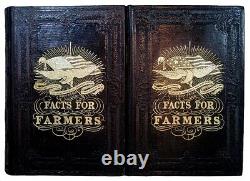

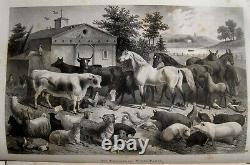
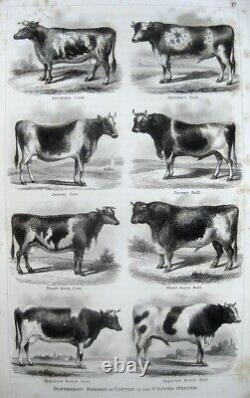
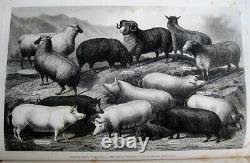
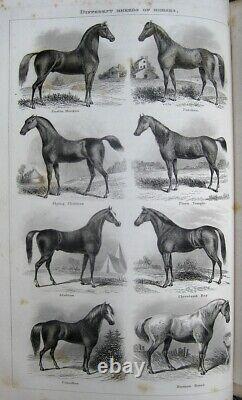
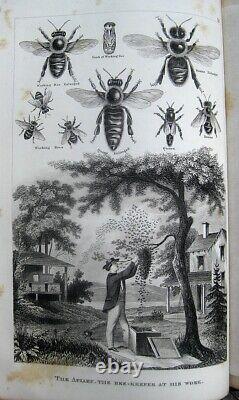
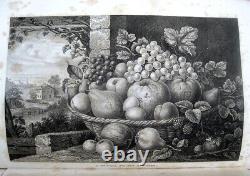
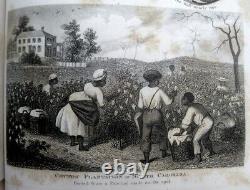
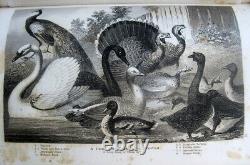



Note: Many of my clients are farmers, agriculturalists, veterinarians, farriers, etc. Who are seeking specific information related to their fields of interest.
For their convenience I include the following details directly from this book. Recipes/Receipts Included in this Book (General Only, See Full Contents Below): Facts for Farmers Solon Robinson Antique Illustrated Steel Engravings Victorian Farm Farming Agriculture Horticulture Fruit Culture Guide Manual Handbook How-To Advice Instruction Post Civil War Era Leather Gilt American Frontier Emigrants Western Pioneers Land Soil Domestic Economy Farrier Horse Cattle Cow Swine Pig Sheep Poultry Chicken Geese Ducks Turkeys Farm Animals Stock Breeding New York Cattle Market Staple Crops Indian Corn Cereals Sugar Cane Sorgum Cotton Rice Tobacco Hemp Flax Orchard Vineyard Garden Culinary Vegetables Dairy Farmhouse Farm Buildings Barn Stable Corn Crib Ice House Smoke House Piggery Farmery Yards Cellars Curing Bacon Bee-keeping Apiary Bees Fertilization Irrigation Fences Fencing Plow Plough Farm Implements Tools Trees Arbor Birds Insects Cultivation Roofing Lightning Rods Breads Recipes for Housewives Domestic Wines Preserves Useful Knowledge for Farm Families Butter Cheese Making Flower Gardens Varieties Lawns Grounds Pruning Grafting Budding Apple Peach Pear Cherry Trees Vineyard Management Grape Culture Wine Making French Wine Maker Rules American Wine Making Rules Wheat Rye Oats Barley Buckwheat Haying and Haying Machines Maple Sugar Making Tapping Hedges Stone Walls Wire Fence Farm Gates. FACTS FOR FARMERS; Also for the Family Circle. A Variety of Rich Materials for All Landowners, About Domestic Animals and Domestic Economy; Farm Buildings; Gardens, Orchards and Vineyards; And All Farm Crops, Tools, Fences, Fertilization, Draining, and Irrigation.
With an Appendix on the Diseases and Cures of Domestic Animals; A Choice Selection of Reliable and Indispensable Law Forms; And Tables Calculating Interest At Any Rate Per Cent, Required. Edited by Solon Robinson, Agricultural Editor of the New York Tribune and Author of Several Popular Works. Published in 1865 by A. Two 10.5" x 7.5" volumes, full leather bindings with elaborate gilt decoration on front boards and spines.Volume I = 514 pages. Volume II = 536 pages.
Condition: VERY GOOD ANTIQUE CONDITION. Two gorgeous antique volumes bound in beautiful black leather with ornate gilt titles and decoration on cover and spine. Both volumes expertly restored by a professional book conservator.
New leather spines with original leather decoration laid on. New inner hinges, reinforced bindings.Pages have some foxing and toning as you might expect after 157 years. No torn, loose or missing pages.
Great example of this antique Civil War era farming guide. FACTS FOR THE FARMER is a veritable storehouse of practical advice and instruction for the proper management of a farm and farm household in the 19th century. Published in 1865, the same year the Civil War ended, this rare two-volume set was designed to aid the veteran farmer and to provide instruction for the novice. The author, Solon Robinson, was the well-known agricultural editor of the New York Tribune and author of several books about agriculture and domestic economy. This is the kind of reference work that farmers old and new would have turned to time and time again.
Whether working an established family farm back east or out west trying to carve out a piece of the American frontier, a farmer in need would have found these books to be a friend indeed. This two-volume set covers every important aspect of farm life and domestic economy including. Domestic Animals - Horses, Cattle, Swine, Sheep and Poultry; Care and Feeding; Husbandry, etc. Staple Crops - Indian corn, Potatoes, Turnips, Beets, Carrots, Onions. Cereal Crops - Wheat, Rye, Oats, Barley, Millet and Buckwheat.
Sugar Crops - Sugar Cane, Chinese Sugar Cane, Sorgo-Sugar Making. Southern Staple Crops - Cotton, Rice, Tobacco, Hemp, Flax and other fibrous plants. The Dairy and Dairy Products. The Farmhouse and Other Farm Buildings - Barns, Stables, Corn Cribs, Ice Houses, Smoke Houses, Fruit-Drying Houses, etc. Plows, Plowing and Farming Tools.
Birds and Insects on the Farm: Good and Bad. Wild and Tame Animals on the Farm. Miscellaneous Items of Useful Knowledge to Farmers and Farm Families.
The author proudly attests to the time-tested value of his instructions and advice. The author asks the reader of this book to judge for himself. He does not advance new theories. He only collects old ones.
He has made a ponderous volume, not of dry dissertations, but of short, crisp facts. The book is full of little things; gleanings from many fields; from all reliable authority; from conversations of farmers; from talks at farmers' clubs; from books a little; from personal experience much; -- from the memory of a long life devoted to the practice and study of agriculture, this volume is born. It is the fruit of years of labor in a great and good field. It certainly contains much that will be useful to all classes who till the earth, or live in farmers' houses. It should be in every rural home, as a work of reference. It is arranged in the most convenient form for this purpose. Each chapter comprises one general subject.Each section embraces a separate branch. Each numbered paragraph is complete in itself, and conveys an item of information.
Each subject is completely indexed. These large, heavy volumes are illustrated with numerous full-plate steel engravings. It is illustrated as no agricultural book in America has ever been, the author exclaims. DON'T MISS YOUR OPPORTUNITY TO ADD THIS RARE 19th-CENTURY MANUAL OF VICTORIAN FARMING AND DOMESTIC ECONOMY TO YOUR OWN COLLECTION!!!CHAPTER ONE - DOMESTIC ANIMALS. Section One - Introduction to Facts About Stock. Section Two - Swine: This section embraces facts about the best breeds, and best mode of feeding, gross and net weight, etc.
Section Three - Cows: What is a good cow, and how to choose one; food necessary; health; profit; kind for butter-making. Section Four - Beeves: Record of the largest known, and their weights. Section Five - Statistics of the New York Cattle Market, and Improvements in Breeds and Weights. Section Six - Feeding Cattle and Care of Farm Stock: Selecting calves; shelter; training; kindness; value of kinds of feed; use of salt; watering; diseases of cattle.Section Seven - Sheep Husbandry: Breeds of Sheep; care and management; weight of hay necessary; mutton and its use; shearing and care of wool. Section Eight - Horses and Mules: History of the Horse; varieties; how to use; proper size; color; diseases; treatment of colts; how to shoe horses; breeding horses and mules; horse gearing. Section Nine - Poultry: Full description of all kinds of poultry and proper treatment. CHAPTER TWO - SMALL ANIMALS AND INSECTS.
Section Ten - Bees: Their history, use and value, management and reasons for keeping. Section Eleven - Birds: Reasons for preserving; their food and laws for protecting. Section Twelve - Entomological: What are insects, and what kinds infest and injure various crops, and how to detect friends from foes, and various remedies. Section Thirteen - Wild and Tame Animals of the Farm: Dogs, cats, rats, mice, moles, rabbits, squirrels, gophers; skunks, toads, goats, camels, and breeding fish for family use. CHAPTER THREE - THE FARMERY: THE BUILDINGS, YARDS, WELLS, CISTERNS, AQUEDUCTS AND STRUCTURES NECESSARY TO CARRY ON THE BUSINESS OF THE FARM, BRIEFLY DESCRIBED. Section Fourteen - Farm-Houses: They should be convenient, roomy, light, ventilated; their influence upon character; old style farm-house described. Section Fifteen - Cellars, Chimneys and Ice Houses: How to build them, and their proper size and use; how to store and keep ice. Section Sixteen - The Barn and Its Appurtenances: Location, size and use of barns; how to build stables; stable yards and cheap sheds. Section Seventeen - Water for the Farmery: Cisterns, size, cost and how to build; aqueducts and wells, how to construct; hydraulic rams. Section Eighteen - Stacking and Storing Grain; Corn Cribs; Piggeries, and Pig Feeding; Smoke-House, and Curing Bacon; Fruit-Drying House. Section Nineteen - Economical Farm Buildings: Balloon frames, concrete walls, and other cheap styles of building; how to make balloon frames, and their cost. Section Twenty - Roofs and Roofing: Paints and whitewash for farm buildings; nails; mortar; farm gates; sawed shingles, their value and how to preserve shingles. Section Twenty-One - Lightning Rods or Conductors: Protection of farm buildings from fire; windmills and their use. CHAPTER FOUR - DOMESTIC ECONOMY.Section Twenty-Two - The Food Question: Quantity, quality, variety, adaptation, adulteration, changes produced by cooking, water for cooking, and effect on health. Section Twenty-Three - The Bread Question: Varieties; quality; how to make bread and yeast; and substitutes for yeast. Section Twenty-Four - Substitutes for Bread: In green corn, dried corn, pop-corn, hominy, and cracked wheat, and how to cook them. Section Twenty-Five - Excerpts of Useful Knowledge for Housewives: Economy of lights; use of tea, coffee and sugar; preserving fruits, pork, hams and beef; remedies and disinfectants; beds and abcxs bedding and carpets, etc.
Section Twenty-Six - Domestic Wines, Cider and Preserves: Rules of wine-making from various fruits, and cider and vinegar making. Section Twenty-Seven - Hygienic: Preparation of food for the sick; remedies for poisons, bites and stings.
Section Twenty-Eight - The Dairy: Butter and cheese making; how much milk for a pound of butter; Alderney butter; dairy room and utensils; working, salting and packing butter. CHAPTER FIVE - THE GARDEN AND ITS FRUITS. Section Twenty-Nine - Pleasure and Profit of Gardening: Origin and history of vegetables. Section Thirty - Garden Culinary Vegetables: Protection from insects; value of various things for food; chicory culture; what should be grown in the garden; number of plants upon an acre. Section Thirty-One - The Flower Garden: Varieties and cultivation of flowers; suitable soil and preparation; lists of choice flowers; flowers grown as a crop.Section Thirty-Two - Lawns: How to make and how to keep them; trees and plants suitable for lawns; botanical names of neetmok trees; roses and their cultivation. Section Thirty-Three - Hot Beds: Cold frames; plant protectors; how to make and use hot-beds. Section Thirty-Four - Small Fruits of the Garden: Currants, varieties and cultivation; strawberries, variety and growth; raspberries; blackberries; quinces.
CHAPTER SIX - THE ORCHARD. Section Thirty-Five - Propagation, Planting and Cultivation of Trees: Time to transplant; preparation; protection, labels for trees.Section Thirty-Six - The Art of Pruning, Grafting and Budding: How and when to prune; how and when to bud and graft; how to make wax. Section Thirty-Seven - Apple and Peach Trees: Their general management; select list of apples and descriptions; peach trees, how to grow; how to treat an old orchard. Section Thirty-Eight - Cherries: Best varieties; soil, situation, and cultivation; history, use and value; grafting and budding. Section Thirty-Nine - Pears: Soil, situation, cultivation and varieties; select list of sorts; when to gather and how to ripen; is the cultivation profitable. Section Forty - Plums, Nectarines, Apricots, Mulberries and Other Fruit: How to transplant fruit; choice selection of plums.
Section Forty-One - Miscellaneous Matters about Fruit Culture: Cranberries as a crop; how to grow them; best varieties; cider-making. CHAPTER SEVEN - THE VINEYARD. Section Forty-Two - How to Plant and Cultivate Vines: What sorts to plant; history of varieties; profits of culture; grape growing in California. Section Forty-Three - Culture of Grapes for Wine: Rules for wine-making; wine from various kinds of grapes; rules of a French wine-maker; rules of American wine-makers. Section Forty-Four - Wheat, Rye, Oats, Barley, Millet, Buckwheat: Preparation of the soil and fertilization; quantity of seed; harvesting, stacking and storing; thrashing and cleaning; profits of wheat culture; oats, how and when to sow; cultivation of barley; buckwheat; millet.
Section Forty-Five - Indian Corn: Its history; product, profit as crop; when to plant, and how to cultivate; great yield per acre; North and South; how to store corn, and how to measure in bulk; seed corn and varieties; broom corn. CHAPTER NINE - THE GRASSES, THEIR CULTIVATION AND USE. Section Forty-Six - Mowing and Pasture Lands: Seeding land; varieties of grass; what is grass; what kinds are recommended for cultivation; clover, its cultivation; harvesting seed. Section Forty-Seven - Haying and Haying Machines: Hay caps; stacking; how much hay land should produce, and how much is necessary to provide; how to measure hay in bulk. CHAPTER TEN - ROOT CROPS AND SUGAR CROPS. Section Forty-Eight - Potatoes, Turnips, Beets, Carrots, Parsnips, Onions: How to plant and cultivate, and how much they should produce; history of the potato; character of varieties; importance of the crop; what seed should be used, and how planted; substitutes for the potato; sweet potato culture; turnip culture; carrots as a crop, and sowing and cultivation; onions as a crop, how grown and profits. Section Forty-Nine - Chinese Sugar Cane, and Sorgo-Sugar Making: Preparation and time of planting cane; soil and situation; harvesting; manufacturing, and yield and profits as a crop. Section Fifty - Maple Sugar Making: Tapping trees; sprouts, buckets, and boilers; process of manufacture; cost, yield and profit of maple-sugar. CHAPTER ELEVEN - FORESTS AND FENCES.Section Fifty-One - Trees and Tree Planting; Wood or Coal for Fuel: What trees to plant, and how and where; descriptive list of trees, value of various trees; how to make timber durable; how to season fuel. Section Fifty-Two - Fences: Their cost; kinds most economical; laws regulating; how to make hedges, stone walls, wire fence, and farm gates; how to kyanize fence posts; waste of land around fences; portable fence, its use. Section Fifty-Three - The Art, Use and Economy of Making, Saving and Applying Manures and Fertilizing Farm Crops: Color, fineness and moisture of manure affects is value; nitrates, muriates, sulphates, lime, plaster and bones, how to apply; guano, its history and use; Doherty's description; muck, its value; sea weed and other matters; value of salt; special manures for various crops; soiling to save manure; manuring with clover; water, its value as a fertilizer. CHAPTER THIRTEEN - IRRIGATION, DRAINING, PLOWING, FARMING TOOLS.
Section Fifty-Four - Irrigation and Tile Draining: Value of irrigation; its practice in Italy and other countries; what lands are most benefited; tile draining, its importance, cost, practice and profit; how and what land should be drained; the mole-draining plow. Section Fifty-Five - Plows and Plowing: History of cast iron plows; subsoil plows, and their use and value; steel plows and steam plows; other farming tools; labor saved by using farm machinery.CHAPTER FOURTEEN - SOUTHERN STAPLE CROPS: COTTON, CANE, RICE, TOBACCO. Section Fifty-Six - History, Growth, Manufacture of Cotton: History of the cotton gin; upland cotton; sea island cotton; how cotton is grown, picked and prepared for market; profit of the culture; flax cotton. Section Fifty-Seven - Sugar Cane Cultivation: Statistics of its culture in Louisiana; yield of sugar per acre; cost of making, and how it is made.
Section Fifty-Eight - Rice: Its cultivation, production, and preparation for market; yield per acre; value and profit; statistics of rice plantations; upland rice. Section Fifty-Nine - Tobacco: Its history, cultivation, production and profits; exports and consumption of tobacco; effect of cultivation upon the soil; its culture in New York and Connecticut; rules for cultivation, curing and packing.
Section Sixty - Cultivation of Hemp, Flax and other Fibrous Plants: Hemp, soil and climate; how it is sown, harvested and yield per acre; cost and profit; effect upon the soil; flax cultivation; how to prepare the soil, sow the seed, and quantity per acre. CHAPTER FIFTEEN - GLEANINGS OF THE FIELD. Section Sixty-One - Miscellaneous Items of Useful Knowledge to Farmers: This last chapter embraces many things not classed under other titles, such as temperature for seeds to germinate and ggrow; nutriment in food substances; weights and measure of grain; measuring land; proverbs and maxims for young and old farmers, farmers' wives and children; maxims of health; things to be thought about; how to dress skins, fix pumps, mend pipes and prognosticate the weather; farmers' clubs; farm laborers; farm accounts; farm economy, and Finis.
APPENDIX - DISEASES AND CURES OF DOMESTIC ANIMALS. Remember folks, this is an original 1865 two-volume set bound in black leather. These books are 157 years old. Please be sure to add me to your List of Favorite Sellers.
Don't miss out on any of my latest listings. When you prepare your listings you generally should use only material text, photographs, etc. And trademarks/names that you created or own yourself or licensed from the owners. Item description text; lists of contents, lists of illustrations/photos; scanned images, etc. UNAUTHORIZED USE OF ITEM DESCRIPTION TEXT INCLUDING SUMMARIES OF CONTENTS, ILLUSTRATIONS, ETC.This item is in the category "Books & Magazines\Antiquarian & Collectible". The seller is "neetmok" and is located in this country: US.
This item can be shipped to United States, Canada, United Kingdom, Denmark, Romania, Slovakia, Bulgaria, Czech Republic, Finland, Hungary, Latvia, Lithuania, Malta, Estonia, Australia, Greece, Portugal, Cyprus, Slovenia, Japan, China, Sweden, Korea, South, Indonesia, Taiwan, South Africa, Thailand, Belgium, France, Hong Kong, Ireland, Netherlands, Poland, Spain, Italy, Germany, Austria, Bahamas, Israel, Mexico, New Zealand, Singapore, Switzerland, Norway, Saudi Arabia, United Arab Emirates, Qatar, Kuwait, Bahrain, Croatia, Republic of, Malaysia, Brazil, Chile, Colombia, Costa Rica, Panama, Trinidad and Tobago, Guatemala, Honduras, Jamaica, Barbados, Bangladesh, Bermuda, Brunei Darussalam, Bolivia, Ecuador, Egypt, French Guiana, Guernsey, Gibraltar, Guadeloupe, Iceland, Jersey, Jordan, Cambodia, Cayman Islands, Liechtenstein, Sri Lanka, Luxembourg, Monaco, Macau, Martinique, Maldives, Nicaragua, Oman, Peru, Pakistan, Paraguay, Reunion, Vietnam, Uruguay.
- Year Printed: 1865
- Country/Region of Manufacture: United States
- Topic: FARMING
- Binding: Fine Binding
- Region: North America
- Author: Robinson
- Subject: Americana
- Original/Facsimile: Original
- Language: English
- Publisher: A. Johnson
- Place of Publication: New York
- Special Attributes: RARE TWO VOLUME SET LEATHER GILT ENGRAVINGS, Illustrated

